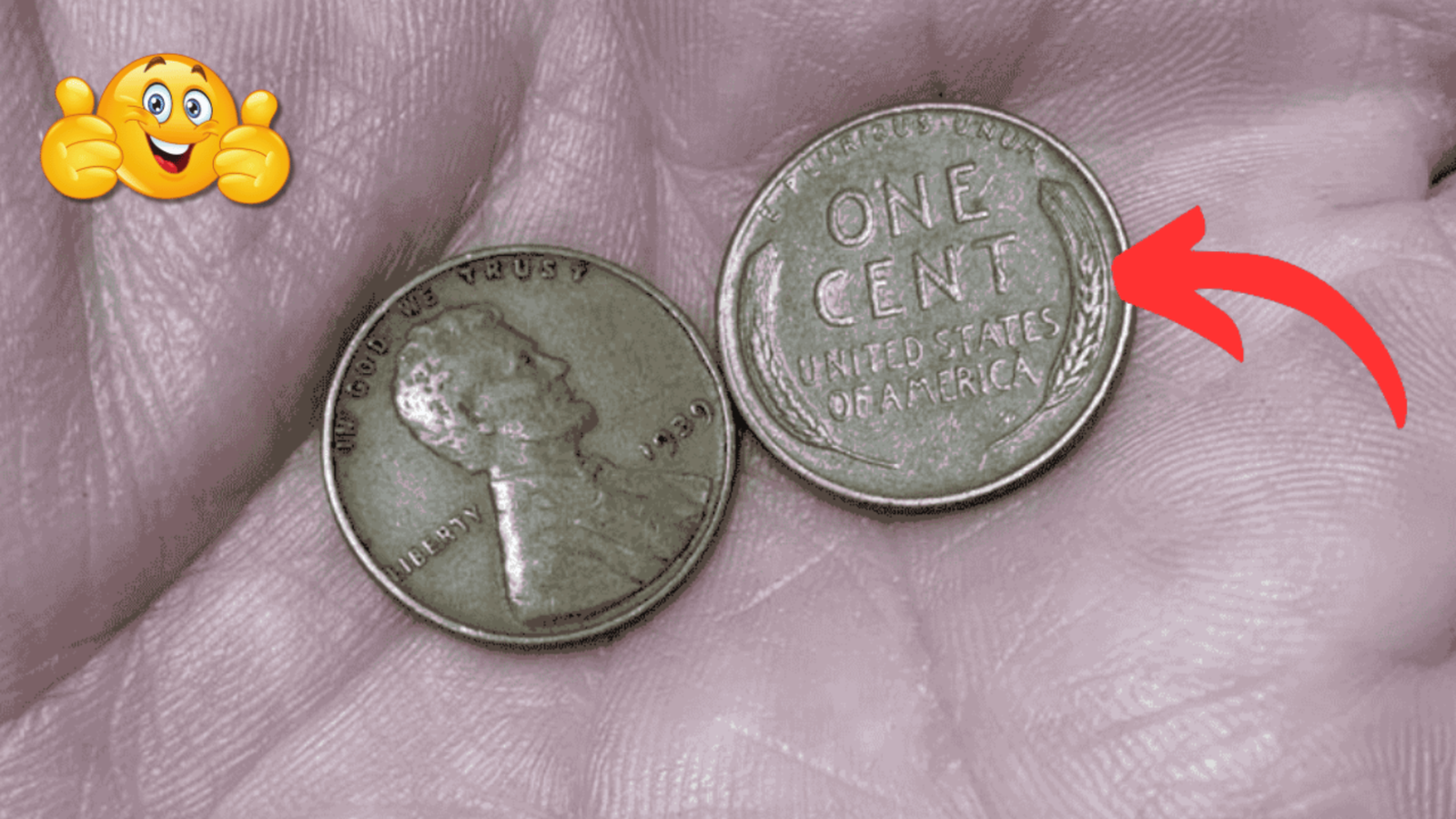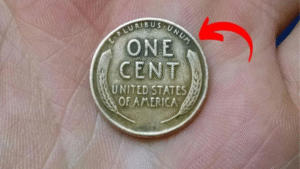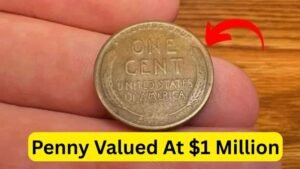Lincoln Wheat Penny Valued at $4.4 Million: The Lincoln Wheat Penny, first minted in 1909 to celebrate Abraham Lincoln’s 100th birthday, was a trailblazer—the first U.S. coin to feature a real person’s face. Designed by Victor David Brenner, the front shows Lincoln’s profile facing right, with “IN GOD WE TRUST” above and “LIBERTY” by the date. The back has two wheat stalks framing “ONE CENT” and “UNITED STATES OF AMERICA,” symbolizing America’s farming roots.
From 1909 to 1958, the U.S. Mint produced over 100 billion in Philadelphia (no mint mark), Denver (D), and San Francisco (S). Made of 95% copper with tin and zinc, they weigh 3.11 grams and glow reddish when new. In 1943, to save copper for World War II, most were zinc-coated steel (gray, 2.7 grams). By 1982, rising metal costs led to zinc cores with copper plating. Common ones are worth one cent, but in 2025, with copper at $4.50 per pound, their melt value is 2-3 cents. Rare dates and errors make them collector favorites, hiding in change or old jars.
Debunking the $4.4 Million Myth
Online stories claim a Lincoln Wheat Penny could fetch $4.4 million, often tied to a “unique 1943 error” still in circulation. But 2025 auction records from Heritage Auctions and PCGS show no Wheat Penny has hit that mark. The top sale is $1.7 million for a 1943-D bronze penny in 2010, with a 2025 Philadelphia example at $144,000. The world’s priciest coin is a 1933 Double Eagle at $18.9 million.
The $4.4 million rumor likely stems from exaggerated social media posts, like a 2025 YouTube video hyping a “lost 1943 bronze” with no proof. These mix real rarities with inflated numbers for clicks. In 2025, with misinformation up 25%, experts urge checking trusted sources like CoinWeek. Real values for top errors range from $50,000-$1.7 million—still exciting without the hype.
The Star: 1943 Bronze Penny
The 1943 bronze penny is a famous error driving massive value. During WWII, the Mint switched to steel pennies to save copper for war needs. A few bronze blanks from 1942 were accidentally struck with 1943 dates, creating reddish, non-magnetic coins (3.11 grams) among gray steel ones (2.7 grams). About 20 exist: roughly 12 from Philadelphia, 4 from Denver, 1 from San Francisco.
Discovered in the 1940s, many were spent or melted before their rarity was known. A 2025 auction saw a Philadelphia bronze in MS-63 fetch $144,000, while the 1943-D’s record is $1.7 million. Values range from $50,000 for circulated to $433,000+ for mint state. In 2025’s hot market, with error coins up 15%, these wartime relics captivate collectors, often found in old rolls or stashes.
Why Some Wheat Pennies Are Worth a Fortune
Value comes from rarity, condition, and story. Key factors include:
- Low Mintage: Years like 1909-S or 1914-D had small runs.
- Condition (Grade): Rated 1-70; MS-65+ (shiny, no wear) boosts prices.
- Errors: Wrong metals, like 1943 bronze, are unicorns.
- Mint Marks: “S” or “D” can signal scarcity.
In 2025, nostalgia and social media drive demand, lifting errors 20%. Authentication fights fakes—use magnets and scales.
Other Valuable Wheat Pennies to Seek
Beyond the 1943 bronze, these stand out:
1. 1909-S VDB
Designer’s initials on back; 484,000 minted. $500-$168,000.
2. 1955 Doubled Die Obverse
Bold doubling on date/words; $800-$125,000.
3. 1914-D
Low 1.2 million run; $200-$20,000.
4. 1922 No D
Missing mint mark; $300-$10,000.
5. 1944 Steel Cent
Steel in bronze year; $5,000-$115,000.
Magnify for doubles or check color for errors.
Table of Top Lincoln Wheat Penny Rarities in 2025
From 2025 Heritage and PCGS data, for VF-20+ condition:
| Variety | Year & Mint | Why Rare? | Value Range | Record Sale |
|---|---|---|---|---|
| Bronze Cent | 1943-P | Wrong metal | $50K-$433K | $144K (2025) |
| Bronze Cent | 1943-D | Ultra-rare | $200K-$2.4M | $1.7M (2010) |
| VDB Initials | 1909-S | Low mintage | $500-$168K | $168K (2023) |
| Doubled Die | 1955-P | Die shift | $800-$125K | $125K (2021) |
| Key Date | 1914-D | Small run | $200-$20K | $20K (2024) |
| No Mint Mark | 1922-P | Die error | $300-$10K | $10K (2022) |
| Steel Cent | 1944-Any | Wrong metal | $5K-$115K | $115K (2023) |
| Key Date | 1909-S | Early scarcity | $400-$15K | $15K (2025) |
| Key Date | 1926-S | S-mint low | $50-$2.5K | $2.5K (2024) |
| Doubled Die | 1942-P | Subtle shift | $20-$1K | $1K (2023) |
Condition sways prices; Red adds premiums.
How to Spot a Rare Wheat Penny
Think you’ve got one? Check these:
- Color Test: Bronze is reddish, non-magnetic; steel is gray, sticks to magnets.
- Weight: Bronze 3.11g; steel 2.7g. Use a pocket scale.
- Magnify: Look for doubling or missing marks with a 10x loupe.
- Tools: Apps like CoinSnap scan for quick ID.
Don’t clean—natural tone adds value. Visit a dealer for a free look.
Hunting and Selling Wheat Pennies in 2025
Search in:
- Bank Rolls: $25 buys 2,500 pennies—sort by date.
- Old Jars: Family stashes or thrift finds.
- Sales: Garage or estate lots for bulk coins.
Selling: PCGS/NGC grading ($20-50) adds a protective slab for trust. eBay for quick sales, Heritage for high bids (10-15% fees). In 2025, error coins are trending—grade for max value.
Conclusion
The $4.4 million Lincoln Wheat Penny myth fuels dreams, but real rarities like the $1.7 million 1943 bronze deliver plenty of excitement. These copper coins, with Lincoln’s gaze and wheat stalks, connect us to America’s past in 2025’s vibrant market. Billions linger, so check your change—verify with pros, and let a penny spark your story. The hunt’s the real treasure.
FAQ
Is a Lincoln Wheat Penny worth $4.4 million?
No, that’s a myth—no penny hits that. Top sale is $1.7 million for a 1943-D bronze.
What’s the rarest Wheat Penny?
The 1943-D bronze, with one confirmed; 1943-S bronze follows.
How to spot a 1943 bronze penny?
Reddish, non-magnetic, 3.11g—not gray steel. Magnify and weigh.
Can I find one in circulation?
Rare but possible—some appear in rolls or old stashes.
Should I clean a Wheat Penny?
No—cleaning scratches, lowering value. Keep natural.
Where to appraise a penny?
Dealers free; PCGS/NGC for grading and high sales.




